Guards miners
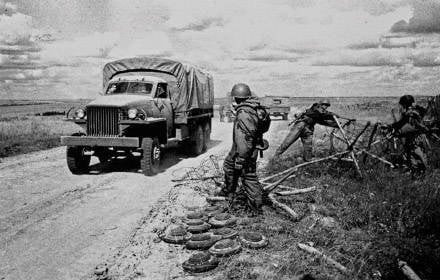 At the very west of the Smolensk region, six kilometers east of the Rudnya – Demidov highway, the village of Mikulino is located. The Trinity Church of the XIX century, several shops and stalls and in the center of the village on a hill, as well as in thousands of other villages and villages of the former Soviet Union, a memorial complex with a statue of a warrior and marble plaques, which carved the names of those killed in the war of fellow villagers and soldiers whose remains were found during search operations. There is the Eternal Flame, which, alas, is now lit only on Victory Day.
At the very west of the Smolensk region, six kilometers east of the Rudnya – Demidov highway, the village of Mikulino is located. The Trinity Church of the XIX century, several shops and stalls and in the center of the village on a hill, as well as in thousands of other villages and villages of the former Soviet Union, a memorial complex with a statue of a warrior and marble plaques, which carved the names of those killed in the war of fellow villagers and soldiers whose remains were found during search operations. There is the Eternal Flame, which, alas, is now lit only on Victory Day.But the main attraction of the village is still a 12-meter obelisk of gray ashlar on a reinforced concrete pedestal, built on 8 in May 1945 by means of soldiers and officers of the engineering troops of the 1 Baltic Front. On the obelisk are depicted six Guards signs, under each of them are ovals with the names of fallen soldiers posthumously awarded the title Hero of the Soviet Union. They are: Senior Lieutenant Nikolai Kolosov, Senior Sergeant Vladimir Goryachev, Junior Sergeant Vyacheslav Efimov, Private Ivan Bazylev, Philip Bezrukov, Mikhail Myagky.
On May 12, 1943, the reconnaissance and sabotage group of the 10th separate guard battalion of miners of the 43rd Army of the Kalinin Front, after a twenty-day raid on German rear and many hours of persecution by the enemy, took battle with the punitive battalion at an altitude of 207,8 near the now defunct village of Knyazhino. For more than three hours, the guards repelled the attacks of the SS, supported by the fire of guns, mortars, adjusted aviation. Having destroyed about 120 enemy soldiers, when all the cartridges were over, the heroes entered hand-to-hand combat.
This fight is forever inscribed in a glorious history battalions of the guard minelayers - the forerunner of the post-war Soviet Army Special Forces GRU. But the creation of these units, in which the “grandfather” of the national special forces I. Starinov took direct part, had its long history ...
“Small war” according to plan “D”
In May 1927, the government of England severed diplomatic relations with the USSR. The threat of foreign intervention has increased dramatically, which in the presence of a poorly equipped 500-thousandth Red Army posed a grave danger. This required a kind of “asymmetrical” response, and as a result, it was decided to return to the idea of a “small war” in the rear of the aggressor with possible transfer of partisan actions to its territory. After all, in the 1921 of M.V. Frunze, he wrote in his article “United Military Doctrine and the Red Army”: “... We see the means of combating the technical superiority of the enemy army in the preparation of a partisan war in the territories of possible theaters of military operations. Hence the task of our General Staff should be to develop the idea of a “small war”. In the USSR, work on the “D” line, as the complex of measures for the preparation of partisan actions was officially called, began as early as 1924 on the initiative of Frunze and Dzerzhinsky. It was conducted through three departments: the OGPU, Rezvedupra and the Comintern. In Belarus, to the beginning of the 1930-ies. they formed six detachments of force up to the battalion each under the command of K. Orlovsky, S. Vaupshasov, V. Korzh, A. Rabtsevich and others, who had already taken part in “active reconnaissance” in Poland in the 1921 – 25 years, and later fought in Spain in 1936 – 39, as well as creating a partisan movement in the German rear in 1941 – 45, for which everyone was awarded the title Hero of the Soviet Union. In Ukraine, detachments numbering over 3 thousand people were ready to move to partisan fighting, plus only in the South-West railway line to a depth of 200 km, was prepared for action over 60 of partisan sabotage groups totaling about 1400 people. In the Belarusian Military District, training was conducted in special schools, to coordinate the educational activities of which, under the auspices of the OGPU, a Special Bureau was established under the leadership of A. Sprogis. In Ukraine, there were six special schools of the OGPU and Razvedupra, where I. Starinov, M. Kochegarov, I. Lisitsyn taught. Here they taught only special disciplines: organization and tactics of guerrilla warfare, the fight against enemy propaganda, mine-disruptive work; study foreign weapons; the use of conspiracy and camouflage; airborne training. In total, more than 5 thousand people and about 250 commanders were trained along the “D” line. In the summer of 1932, secret maneuvers took place near the city of Bronnitsy, in which paratrooper guerrillas under the command of S. Vaupshasov, the special division of the OGPU, and the personnel of the Higher Border School took part.
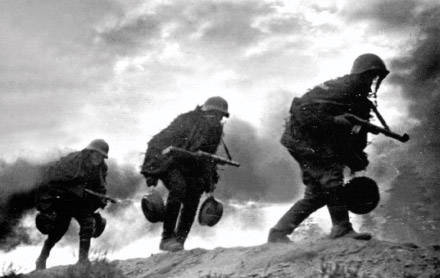 In the autumn, select special groups of three Western military districts were operating on the maneuvers in the Leningrad Military District - in total over 500 people armed with various types of mines. During the exercises, the "guerrillas" penetrated into the "rear of the enemy" by land through the "front line" and through the air using parachutes. Small sabotage groups operated very effectively on the "enemy" lines of communication. The experience of these exercises allowed to begin the formation of regular subversive units for action on the territory of the enemy. For example, on January 25, 1934 issued a directive to the Chief of Staff of the Red Army 1371ss on the formation of “sapper-camouflage” platoons subordinate to the head of the intelligence division for each division on the western border. Their tasks included: crossing the state border, entering the designated area, conducting sabotage, creating panic, disrupting mobilization, liquidating command personnel, disorganizing the rear. A platoon of 40 people, where fighters were selected only for the second year of service, had to act in the enemy's rear in small groups of 5 – 7 people. Soon this tactic was to be tested in combat conditions.
In the autumn, select special groups of three Western military districts were operating on the maneuvers in the Leningrad Military District - in total over 500 people armed with various types of mines. During the exercises, the "guerrillas" penetrated into the "rear of the enemy" by land through the "front line" and through the air using parachutes. Small sabotage groups operated very effectively on the "enemy" lines of communication. The experience of these exercises allowed to begin the formation of regular subversive units for action on the territory of the enemy. For example, on January 25, 1934 issued a directive to the Chief of Staff of the Red Army 1371ss on the formation of “sapper-camouflage” platoons subordinate to the head of the intelligence division for each division on the western border. Their tasks included: crossing the state border, entering the designated area, conducting sabotage, creating panic, disrupting mobilization, liquidating command personnel, disorganizing the rear. A platoon of 40 people, where fighters were selected only for the second year of service, had to act in the enemy's rear in small groups of 5 – 7 people. Soon this tactic was to be tested in combat conditions.Thunder thirties
The first combat run-in of their theoretical and practical developments Soviet saboteurs were held during the Spanish Civil War. At the initiative of the senior military adviser Yakov Berzin, who led the Intelligence Agency before 1935, an entire assault of partisan war specialists was sent to Spain, both through military intelligence and the NKVD. At various times, A. Sprogis, H. Salnyn, H. Mamsurov, S. Vaupshasov, K. Orlovsky, N. Prokopyuk, V. Troyan, V. Korzh, A. Rabtsevich, N. Patrahaltsev, M. took part in the hostilities. Kochegarov, I. Starinov. At the end of 1936, the first sabotage group of 12 people was formed in Valencia. The sabotage actions at the first stage of the war were conducted in small groups, then by 50 – 100 people, who were taken to the enemy’s rear on foot. The duration of the actions ranged from 10 days to 3 months. Subsequently, they were combined into a 14 guerrilla corps of about 3 thousand people under the command of captain Domingo Ungriya, who was subordinate to the intelligence department of the headquarters of the Republican army and where I. Starinov was the first adviser.
The largest operation of the partisans was the destruction of the 1937 in February under the Cordova train with the headquarters of the Italian Air Division. In the summer of the same year, as a result of sabotage, the link between the Madrid and Southern fronts of the Francoists was interrupted for a week, and the commander of the Southern front, General Chiappo de Llano, issued an order imposing martial law in the provinces of Seville, Huelva and Badajoz.
The war in Spain showed the high effectiveness of sabotage operations in the enemy's rear: dozens of blown-up bridges, ammunition depots and fuel, more than 30 railway trains with equipment and equipment, hundreds of kilometers of disabled railways proved the need for special units. The Red Army became the owner of the most modern sabotage techniques and tactics. Subsequently, more than 80% of the guerrilla commanders in France, Bulgaria, Yugoslavia, Czechoslovakia and other countries during the Second World War were prepared either by the direct participants of the partisan war in Spain, or by the instructors trained by them.
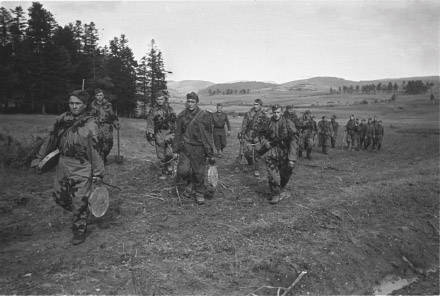 However, unfolding in 1937 – 38. massive repression made this unique experience unclaimed. Many theorists and organizers of guerrilla warfare were shot down: A. Egorov, I. Yakir, I. Uborevich, J. Berzin, H. Sallnyn, repressed almost the entire leadership of the Intelligence and intelligence services of the western military districts, as well as many leaders of the partisan detachments. Work on the “D” line was completely curtailed, caches, warehouses with weapons and ammunition were destroyed. This seriously slowed down the development of the Soviet special forces. The very concept of “saboteur” has become too dangerous sense ...
However, unfolding in 1937 – 38. massive repression made this unique experience unclaimed. Many theorists and organizers of guerrilla warfare were shot down: A. Egorov, I. Yakir, I. Uborevich, J. Berzin, H. Sallnyn, repressed almost the entire leadership of the Intelligence and intelligence services of the western military districts, as well as many leaders of the partisan detachments. Work on the “D” line was completely curtailed, caches, warehouses with weapons and ammunition were destroyed. This seriously slowed down the development of the Soviet special forces. The very concept of “saboteur” has become too dangerous sense ...The consequences of this short-sighted decision of the country's military-political leadership appeared during the war with Finland over the 1939 – 1940 years. Excellently possessing small arms and skis, Finnish sabotage detachments skillfully inflicted considerable losses on the Soviet troops, not only in the rear of the Red Army, but also on Soviet territory. On the initiative of the Chief of the Red Army Intelligence Division of the Red Army commander I. Proskurov, a special ski detachment was formed under the command of the head of the “A” department, Colonel H.-W. Mamsurova. The personnel of this squadron in the number of 300 people were recruited from Leningrad volunteers and students of the Institute of Physical Education. PF Lesgaft. The detachment operated at a distance of 120 – 150 km from the front line. (For more on this: "Brother", March 2010, "GRU Skiers"). The Finnish War revealed the need to create regular reconnaissance and sabotage units within the Red Army. At a meeting in April of 1940, Colonel Mamsurov stressed: “I think it is necessary to solve the issue of creating such special units in a number of districts in order to start preparing them. In the hands of the chiefs of staff of the armies or command of the armies, these units will benefit by performing, in addition to special work, also tasks of more distant reconnaissance than those conducted by the troops. ” But, alas, on the eve of the war, little was done in this direction. The Red Army, with stubbornness worthy of a better use, was preparing for a fight with the enemy on its territory ...
War. Hard lessons
“... In the territories occupied by the enemy, create guerrilla groups and sabotage groups to fight parts of the enemy army, to incite guerrilla warfare everywhere and everywhere, to blow up bridges, roads, damage telephone and telegraph communications, arson of warehouses, etc.,” in the directive of the Council of People's Commissars of the USSR and the Central Committee of the CPSU (b) of 29 June 1941. As a result, the organization of the guerrilla war took place all at once. First of all, it was the party organs, units of the NKVD and the NKGB of the USSR, special departments at all levels, the Intelligence Department and intelligence departments of the fronts and armies and even district military registration and enlistment offices. It must be admitted that soon the leading role in this regard began to be played by the NKVD, or rather, its 4 control under the direction of P. Sudoplatov, within whose framework the legendary OMSBON was formed. But if in the middle of 30 the training of a saboteur was diverted from 3 to 6 months, now it was reduced to 60 hours at best. Such poorly trained groups, having insignificant reserves of explosives and ammunition, as a rule, not having radio contact with the center, after completing two or three tasks resolved questions only of their survival in the enemy rear and, having no combat experience, quickly died. Thus, the losses of special groups in the line of the NKVD in 1941 amounted to 93%, and in the line of military intelligence to 50%.
In this situation, only those detachments survived, whose commanders had the experience of guerrilla warfare during the Civil War, underwent pre-war special training, or simply frontier or elementary combined-arms. These were detachments of V. Korzh, S. Kovpak, S. Rudnev, M. Naumov, K. Zaslonov, and others. But still, these and hundreds of other spontaneously-formed partisan detachments from the local population and the surrounding forces numbering up to the end of 1941 before 90 Thousands of people failed and simply could not strike the communications of the Wehrmacht and cut off the enemy’s rears from the front lines. The Wehrmacht, however, could almost freely transfer its troops and equipment to problem areas and thereby stabilize the position of the front, especially in the battle of Moscow. It became obvious the need to throw into the rear of the enemy, and by air, well-trained and equipped small sabotage groups that would mine his communications, bridges, warehouses and other important facilities.
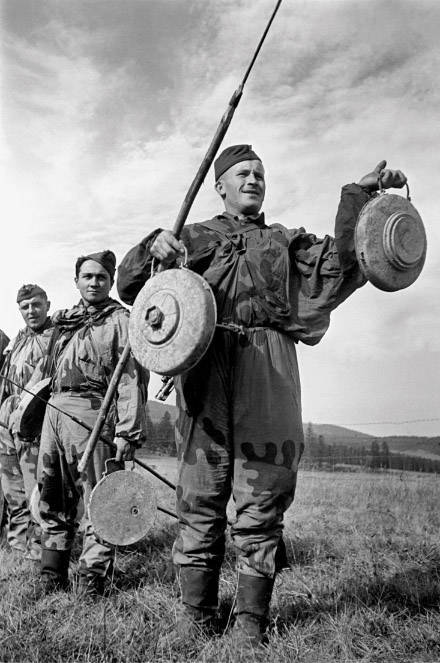 The chief initiator and “pusher” in the idea of creating such units was the chief of staff of the Red Army engineering troops, the already mentioned Colonel Starinov, who distinguished himself in Spain. Having headed the operational group of the Southern Front in the winter of 1941–42, he, with the support of the front commander R. Malinovsky, also a participant in the Spanish war, achieved the creation of a special battalion of miners in the 56th Army for operations on the occupied coast of the Sea of Azov. In January-February 1942 saboteurs destroyed over 100 enemy soldiers, incapacitated 56 vehicles and 2 tank2 blew up bridges.
The chief initiator and “pusher” in the idea of creating such units was the chief of staff of the Red Army engineering troops, the already mentioned Colonel Starinov, who distinguished himself in Spain. Having headed the operational group of the Southern Front in the winter of 1941–42, he, with the support of the front commander R. Malinovsky, also a participant in the Spanish war, achieved the creation of a special battalion of miners in the 56th Army for operations on the occupied coast of the Sea of Azov. In January-February 1942 saboteurs destroyed over 100 enemy soldiers, incapacitated 56 vehicles and 2 tank2 blew up bridges.In May, 1942, the Chief of the General Staff, A. Vasilevsky, ordered an engineering battalion to be allocated on every front for sabotage, and a company in each army. The very same Starinov headed the 5-th separate engineering special-purpose brigade on the Kalininsky front, which only in June sent 76 groups of miners to the front line. And already 23 July 1942, the Soviet Information Bureau reported that "the unit commanded by Colonel Starinov, derailed enemy echelons" 10.
In his letters to Stalin, at meetings with K. Voroshilov, M. Kalinin, G. Malenkov, N. Voronov, Starinov insistently argued the need for special forces and a special sabotage brigade based on the airborne troops. But the difficult situation near Stalingrad and in the Caucasus forced the Soviet command to send all airborne troops to this direction as usual rifle troops. As a result of 17 August 1942, by the order of the People's Commissar of Defense, in the engineering troops of each front, separate guard battalions of miners and a separate guard brigade of miners at the Supreme Command Headquarters "to mine and destroy communications in the rear of the enemy" were created. And the “restless” Colonel Starinov was sent to the newly created Central Headquarters of the partisan movement to lead the sabotage Higher Operational School of Special Purpose ...
Guards miners in battle
In fact, it was about the birth of a new form of combat use of engineering troops. In total, the 1942 was formed in the autumn of 20 by individual guards battalions. Of these, five battalions by the end of the year became part of a separate brigade of guard minelayers with a total of 2281 people. By October 1 1942 in the army already had ten such battalions, usually one battalion per active front. Two battalions were formed on the Karelian, Leningrad and Don fronts.
The “advance” battalions were given the rank of Guards when they were formed along with the units of the Airborne Forces and the units of rocket artillery. The composition of the new parts were selected primarily volunteer sappers who had combat experience. Then they underwent special training in a mine case, landing, hand-to-hand fighting techniques, topography, were provided with explosives and thrown over the front line in small groups. The group consisted of no more than 10 people, several groups were united in the squad. When they were thrown behind enemy lines, the miners were usually based in partisan detachments, trained them in methods of undermining various objects, and supplied them with mine-explosives. Special instructions determined the actions in the enemy's rear area: the order in which to perform combat missions, the rules for moving or flying over the front line. For example, it was recommended to engage in an armed clash with the enemy in exceptional cases, decisively and boldly destroy his small groups with cold weapons or rifle fire with the Brahmit device, which quenches the sound of a shot. Combat missions for reconnaissance in operational depth and the destruction of railways and highways, bridges, and explosions of echelons put the front headquarters for minerals according to the plan of the head of the engineering troops after approval by the military council. 18 April 1943 The leadership of reconnaissance and sabotage work in the temporarily occupied territory of the USSR was entrusted to the Intelligence Service of the General Staff. The 2 Division of Major-General N. Sherstnev was responsible for it, and specifically for the sabotage direction, Colonel Kosivanov, who had a special squadron under command of operations in the rear of the enemy, commanded by Major Tsutsayev.
In January-February, 1943 from the personnel of the 15 th separate guards battalion of the miners of the North Caucasus Front and the Spanish communists, students of the High Special Purpose School of Colonel Starinov, was formed and landed on 16 parachutes of commando groups (120 people) to the rear the enemy in the area between Rostov, Salsk, Tikhoretskaya and Krasnodar, where groups of lieutenants Campillo, Lorente and Konizares distinguished themselves. Later the groups were taken to the rear of the enemy by sea and by air to the areas of Novorossiysk and the Crimean Peninsula in order to disrupt traffic on the Dzhankoy-Vladislavovka-Kerch railway. The battalions where the front stabilized long ago in the wooded and marshy terrain: on the North-Western, Kalinin and Western fronts acted most actively. Thus, the 9-th separate Guards battalion of the miners of the North-Western Front, Lieutenant Colonel A. Galli, in the period 1942 – 44. derailed 108 echelons, blew up 47 bridges and blew 30 km of track on the Luga – Pskov – Dno sections.
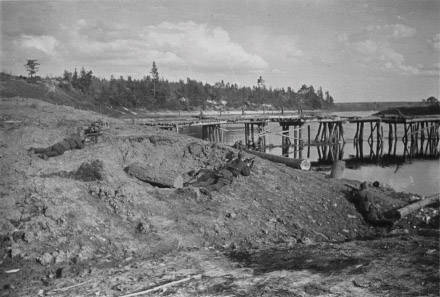 10 March 1943. A mine-explosive platoon of Junior Lieutenant I. Kovalev was abandoned in the Pskov Region. During the seven months of fighting in the enemy's rear, the Kovalev group detonated military echelons 16, undermined 17 bridges, destroyed more than 1,4 km of communication lines, 2 tank, 1 armored vehicle, participated in battles against three punitive expeditions. During this time, Kovalev and his comrades trained the 350 partisans. 4 June 1944 Mr. Ivan Kovalev was awarded the title Hero of the Soviet Union.
10 March 1943. A mine-explosive platoon of Junior Lieutenant I. Kovalev was abandoned in the Pskov Region. During the seven months of fighting in the enemy's rear, the Kovalev group detonated military echelons 16, undermined 17 bridges, destroyed more than 1,4 km of communication lines, 2 tank, 1 armored vehicle, participated in battles against three punitive expeditions. During this time, Kovalev and his comrades trained the 350 partisans. 4 June 1944 Mr. Ivan Kovalev was awarded the title Hero of the Soviet Union.In the spring of 1943, in preparation for the Smolensk operation, the 10 battalion of the Kalinin and 11 battalions of the Western Front sharply intensified. In mid-March, four detachments of miners of the Western Front were ejected into the areas of the Minsk-Orsha, Minsk-Gomel, Novozybkov-Unecha highways. The group under the command of guard senior lieutenant V. Bugrov distinguished itself here, which acted in the enemy's rear for about three months in the area of the village of Smilizh in the Suzemsky region of the Oryol region. The group has repeatedly left the enemy ring, but even having lost half of the personnel, managed to cause considerable damage to the enemy. And only 26 May 1943 g., Completing the combat mission, the group crossed the front line.
The command of the Kalininsky front sent several sabotage and reconnaissance groups of the 10-th separate battalion of miners to the area of the town of Rudni. One of these groups, abandoned on April 22 1943, was commanded by Senior Lieutenant N. Kolosov. Landing on the territory of the Rudnyansky district of the Smolensk region, the miners established contact with the partisan detachment under the command of Vishnev and, together with his demolition men, began to derail enemy trains, detonating fuel and ammunition depots. 8 May 1943 g. Group received an order: on the Golynki-Lelekvinskaya stretch to undermine the enemy’s train, scout the traffic on the Vitebsk-Smolensk motorway and blow up the bridge. “All the time I am leaving from persecution,” was the last radiogram of Kolosov. Six guardsmen of the miners came to the village of Knyazhino, where at the height of 207,8 the partisans left for them a cache of explosives and ammunition. It was here that they committed their immortal feat ...
In battles on the territory of the Liozno district of the Vitebsk region of Belarus, the commander of the 10 division of the separate battalion of the miners of the Guard was particularly distinguished by senior sergeant D. Yablochkin. At the beginning of May, 1943, leading a group of 4 miner-parachutists, he was thrown into enemy rear for sabotage work on the section of the Vitebsk-Smolensk railway, where the group reconnoitered the German defensive line, field airfield, artillery depot and other objects that were destroyed by Soviet aviation. For two weeks, the group blew up two echelons and a backup locomotive. In June, YNBlochkin was surrounded by the Germans during the reconnaissance exit, 1943 was killed in a shootout over 10, but he himself was seriously wounded and captured. A German officer fired a shot at his head. The bullet went casually, and Yablochkin survived. Then the Germans began to finish him with rifle butts, smashed his head, stabbed him with a bayonet, cut off a Guards badge, stripped and, considering dead, threw it under a tree. After 10 hours Yablochkin came to his senses. Wounded, bleeding, overcoming pain and hunger, only after 2 of the month did he find his group of guardsmen in the forest, joining the local partisan detachment. During this time, Yablochkin had to lie with disguise for many days disguised in marsh bushes. The enemy was everywhere, the Germans passed literally several times in 2 meters, but Yablochkin didn’t betray himself.
66 days with the gravest wound of the Guard, senior sergeant Yablochkin lived surrounded by Germans. 23 August 1943. After an almost 4 month stay in the enemy's rear, he was taken by plane to the mainland. 4 June 1944 Yablochkin was awarded the title Hero of the Soviet Union.
The name of another brave mine guard from the 10 battalion of captain Peter Andrianov was a large Volga ship. At the end of August, Andrianov’s 43 detachment led a group of civilians to 600 out of the front line, and in September, the captain defused and captured 88 enemy saboteurs disguised in the Soviet uniform. In June, 1944 was a group of Captain Andrianova, surrounded by large German forces, fighting all day. Having cleared the way with grenades, closer to the twilight the captain led his people to a breakthrough, but died the death of the brave ...
And again in the sappers
Guards miners inflicted significant blows to the communications of the Wehrmacht, disrupting plans for the delivery of military equipment and troops to the front. They also diverted a large number of German troops to guard railways and highways, bridges, warehouses, and other structures. Minera groups very often became the backbone for the creation of partisan detachments. Their actions, receiving high marks from the military councils of the fronts, made a worthy contribution to the cause of the common victory over the enemy.
But, alas, the capabilities of the guard miners were not used properly due to their lack of sufficient radio communications and insufficient centralized control over their actions.
But the most important thing is that in 1943 the guards miners were “superfluous” in the sabotage system of the Red Army. By this time, a mass guerrilla movement in the enemy's rear was deployed, directed and supplied by the Central Headquarters of the partisan movement, and the “competitors”: the 4 NKVD and the Intelligence Directorate of the General Staff accumulated a certain combat experience, had a different approach to preparing and sending sabotage groups. Thus, the functions of sabotage operations were already completely entrusted to the guerrilla formations and reconnaissance units of the army and front-level and OMSBON units.
Since the summer of 1943, the process of reshaping and transferring parts of the former miners back to the Directorate of the Engineering Forces of the Red Army began. Already in August, the 1-I separate mine guard brigade was reorganized into the 1 Guards assault engineering sapper brigade, designed to storm the settlements adapted to the defense and to break through the heavily fortified defense zones.
The main feature of the brigade was a steel bib made of thin armored steel, equipped with an articulated "apron", because of which the sappers received the nickname "armored" infantry. By June 1944, all the battalions of the miners were reorganized into separate guards engineering and engineer battalions for various purposes. The exception was only two battalions. Thus, the 6 th separate battalion of the Karelian Front miners existed until December 1944. Before the Petsamo-Kirkenes operation in September 1944, two detachments (133 and 49 people) from the battalion were sent to the enemy rear. They were to sabotage the Petsamo-Tarnet, Luostari-Akhmalahti and Akhmalahti-Nickel highways. In just the 29 days spent behind enemy lines, the 6 fighters of the separate guard battalion of the miners destroyed the 11 km of a wired communication line, four bridges, destroyed 19 vehicles, three motorcycles, an 31 horse, and many enemy soldiers and officers.
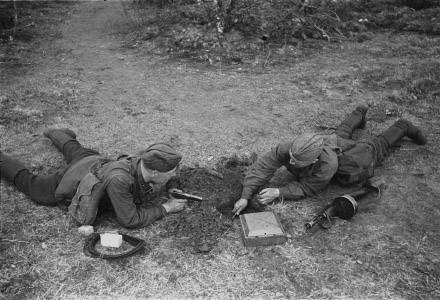 The only part of the Guard minelayers that existed until the end of the war was the 9 Battalion of the North-Western Front. 20 November 1943. He was transferred to the reserve of the Supreme Command Headquarters and redeployed to the territory of the Moscow Military District in the village of Zhelyabino. The battalion became a training center and a kind of reserve for the preparation of reconnaissance and sabotage groups of the Intelligence Directorate of the General Staff, acting in the interests of intelligence departments of various fronts. The training ground of the battalion was located in the vicinity of the Teikovo town of the Ivanovo region. Here the personnel, replenished from the 14 battalion of the Guards. miners, was trained in conjunction with the Polish, Baltic, German anti-fascists. The reconnaissance and sabotage groups from the battalion successfully operated during the Belarusian, Baltic, East Prussian, Vislo-Oder and Berlin operations.
The only part of the Guard minelayers that existed until the end of the war was the 9 Battalion of the North-Western Front. 20 November 1943. He was transferred to the reserve of the Supreme Command Headquarters and redeployed to the territory of the Moscow Military District in the village of Zhelyabino. The battalion became a training center and a kind of reserve for the preparation of reconnaissance and sabotage groups of the Intelligence Directorate of the General Staff, acting in the interests of intelligence departments of various fronts. The training ground of the battalion was located in the vicinity of the Teikovo town of the Ivanovo region. Here the personnel, replenished from the 14 battalion of the Guards. miners, was trained in conjunction with the Polish, Baltic, German anti-fascists. The reconnaissance and sabotage groups from the battalion successfully operated during the Belarusian, Baltic, East Prussian, Vislo-Oder and Berlin operations.During their war years, the guards minelayers were essentially military partisans, but their formation and military use marked the beginning of the creation of the Soviet special forces. And it is not by chance that Marshal Vasilevsky, who signed the order to create them in 1942, already in the rank of Minister of War 25 of October 1950 ordered the creation of separate special purpose companies under the leadership of the Main Intelligence Directorate of the General Staff.
Information